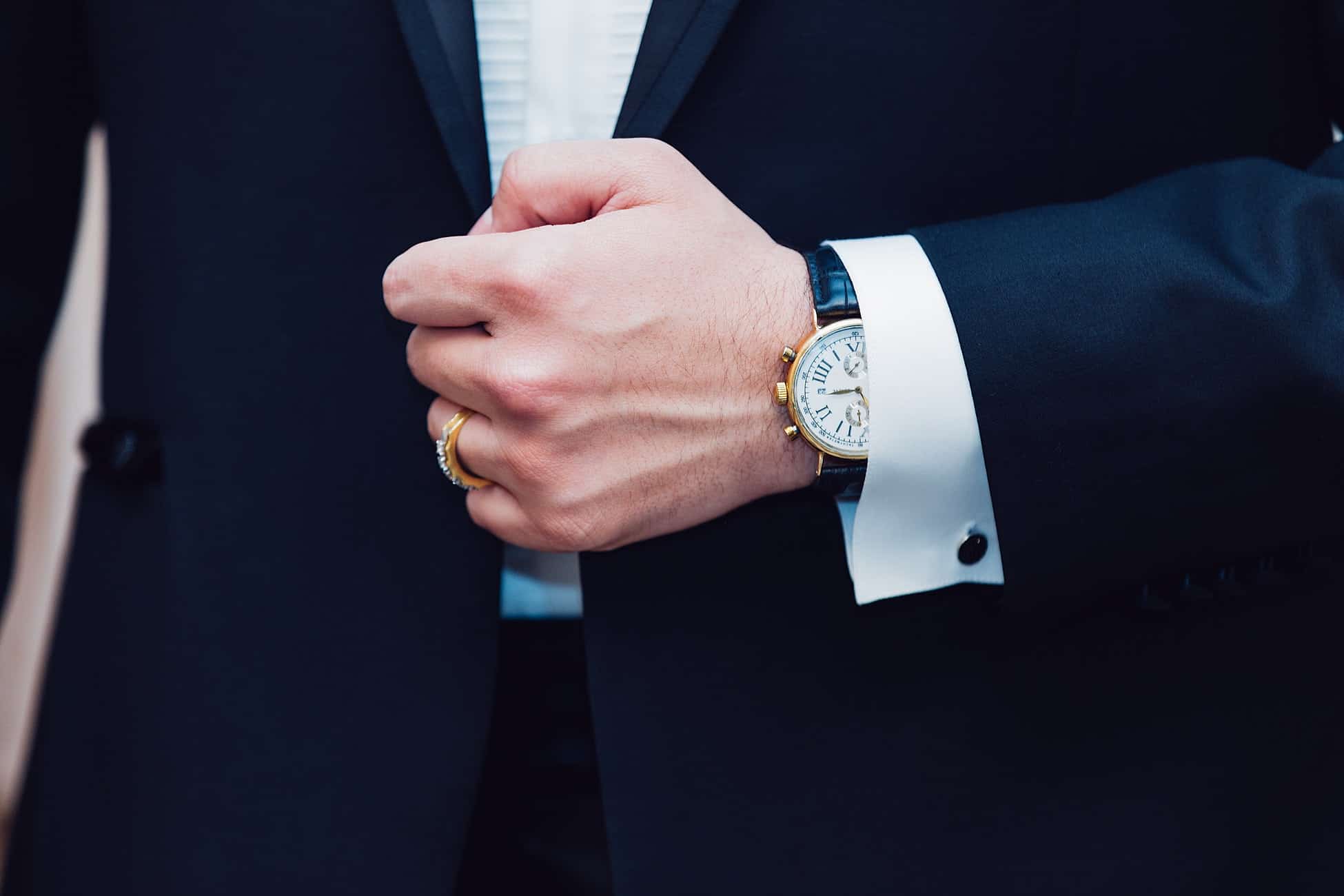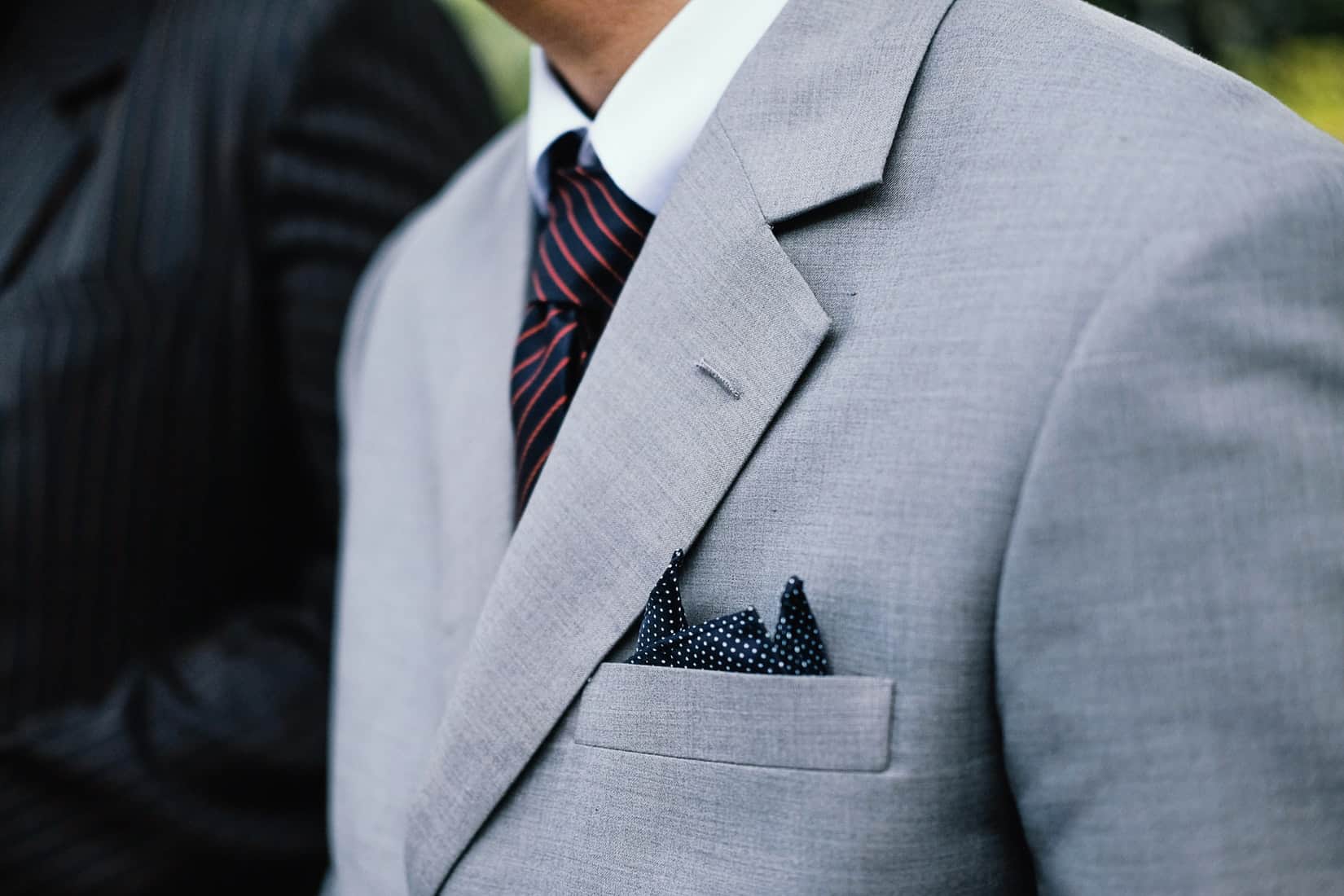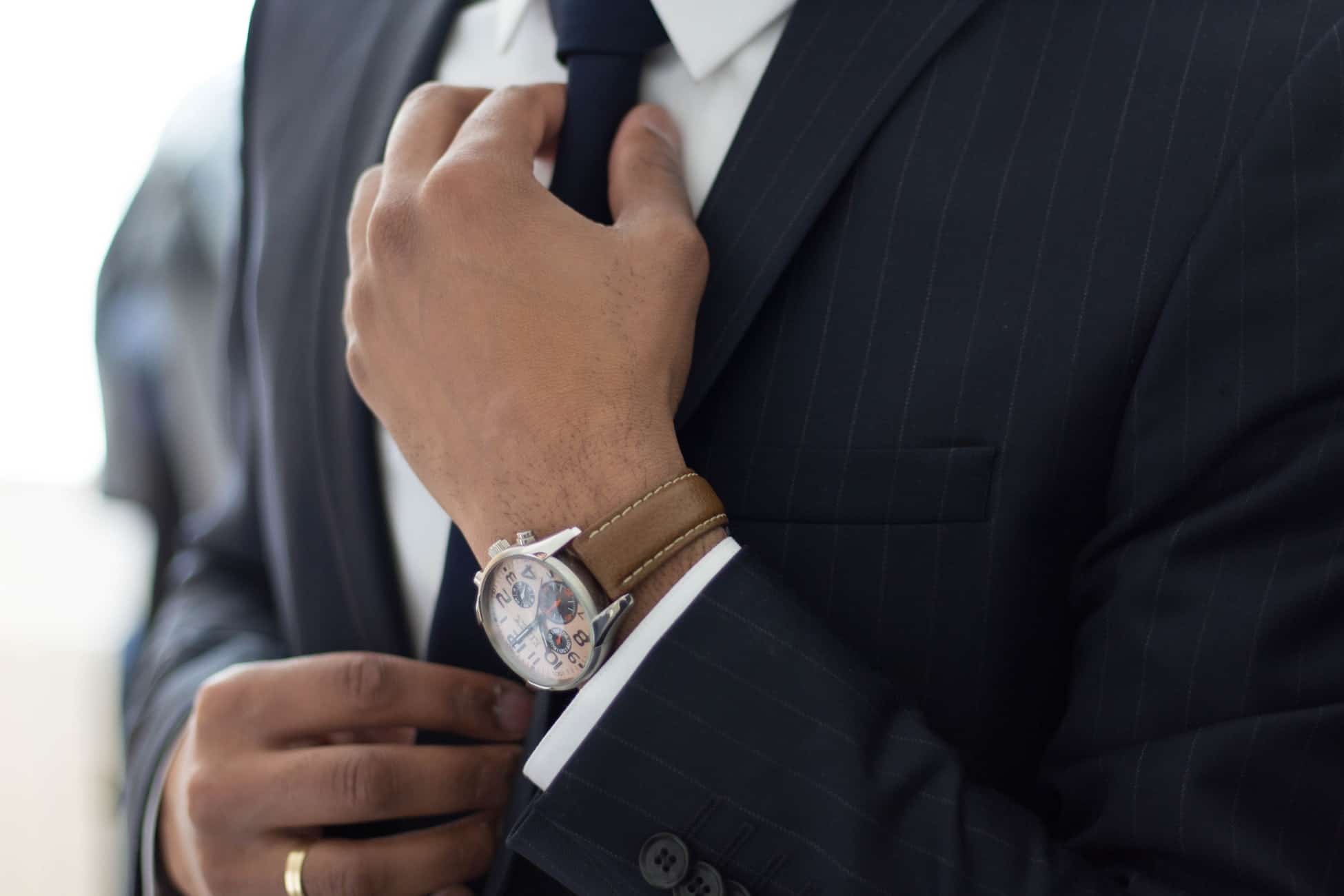Suits are not going out of style and they’re not likely to anytime soon. If a man shows up to a meeting or most other occasions wearing a suit, no one will take offense. On the other hand, if a man shows up to a meeting without wearing a suit and tie, people will wonder why he didn’t and may even become offended by it. Suits are style magnets and have been for over a hundred years. Here we answer questions you might have about suits and offer a complete guide to buying a new suit on a budget.
Why should men buy suits? The answer is because suits make a positive statement to others. Suits make a man look impressive and one who is highly competent in his business or occupation.
Table of Contents
Formal vs. Informal Suits
Let’s imagine that you walked onto the sales floor of a store and you were looking to buy something that cost a couple of thousand dollars. You are approached by two salesmen at the same moment. One of them is wearing a suit, with a matching tie and polished, new-looking shoes, and the other is wearing khakis and a button shirt with worn-looking suede loafers. You have to choose between them. Which one would it be?
Most of us would choose the salesman wearing a suit. Have you wondered why, in life, that we choose better-dressed people to help us than those who look casual, or even somewhat disheveled?
Humans rely on first impressions and make conscious or unconscious deductions about people we meet for the first time, based on the initial impression they make on us. This goes back hundreds of thousands of years in our evolution, and it boils down to a fundamental question: Can I trust him? The answer, usually, is that a person who dresses in a suit is more trustworthy than someone who wears casual clothing in situations when trust is needed, like when buying something from a salesman or being represented by an attorney in court.
Now, let’s imagine you are meeting a woman for the first time. It could be a blind date, or you are at a party or some other gathering. The woman will set her eyes on you wearing a suit. Suits flatter men’s bodies and hide aspects of our bodies that we don’t like but will improve upon when we have time. Maybe we have extra weight in the middle. Suits tend to conceal what men consider their “body imperfections.”
You approach this woman and her eyes will always seek out your eyes first. Next, she will have a quick glance at your shoes, but the real deal-maker is always what you are wearing. Women can hide the fact that they’re checking you out. They are experts at it. However, they cannot hide their feelings about your appearance. If you are wearing a fashionable suit that is pressed and clean, she will likely have a positive reaction, meaning you have made a positive first impression.

Her positive response gives you a surge of confidence, making talking to her much more relaxed and positive. Chances are if the conversation goes well, you have a much greater chance to go on a date, and the one thing she’ll remember later on is how well-dressed you were in your stylish suit.
Suits convey to others that a man possesses self-confidence, is in control of himself, and, on an unconscious level, a suit conveys respect for others and of oneself. A person you meet who wears a suit is telling you without words that he respects you and respects himself. Being well-dressed is a sign of courtesy to others, and everyone appreciates being shown common courtesy.
Suits convey gentlemanly manners, a sense of fashion, and respect. We are likely to defer more to the judgment of someone dressed in a suit than someone who wears something else. This goes back to the two salesmen analogy. If you’re making a large purchase, you might trust the suited salesman instead of the one wearing casual clothing.
I was born in New York and worked in Manhattan for over two decades. In the 21st century, suits are still standard clothing that’s required for most office positions. If you are caught without one (as happened to me on a few occasions), the eyes of others look upon you poorly, even to the point of being ostracized. New York has a lot of investment bankers, corporate directors, and managers. The stock market is on Wall Street and if you ever looked at a video of workers at the New York Stock Exchange, you’ll see most of them are wearing suits.
Suits are still required clothing in Manhattan even if the rest of the country has begun a dressing down trend, working without ties and substituting a sports jacket for a suit jacket. But just place these people in the situation of the salesman, or the guy going out on a blind date. Is a suit more persuasive, and does it make a more profound statement about you and your sense of fashion? Absolutely!
How Many Suits Should I own?
The answer to this question is based on several factors, including
- What is the dress code at your job, and do you want to further your career?
- What social events do you normally attend?
- How often do you believe you will wear a suit?
Generally, it is believed that men should own a minimum of three business suits. The suits should be in these colors.
- Navy blue
- Charcoal
- Black
Black
Black is the most formal suit color out of the three. It should be worn for board meetings, funerals, and public speaking. By far, black makes the most powerful impression. You often see presidents, mob leaders, government officials wearing black. Tuxedos are black, and black is worn for “black-tie” party occasions. If you have a competitor in whatever field you’re in (sales, real estate, competition for promotions, etc.), always wear a black suit to intimidate and command authority. Black is referred to as a “confidence color,” because it communicates that you are in complete command and are brimming with confidence.

Charcoal
Charcoal color conveys trust to everyone who sees you wearing a charcoal colored suit. Many attorneys can be seen wearing suits of a charcoal color because it helps them to earn the trust of the jury. Charcoal is neither light nor dark, nor does it communicate that one is out to lead. It is the suit color you’d wear in sales or the law.

Navy
Navy is a color of power. It’s a dark shade of blue, so it’s more subdued than blue. It’s the color for those who are the leaders at their jobs – managers and directors. If you are up and coming in your profession, wearing blue tells those who have the authority to promote you that you’re competent to handle the responsibilities of the new position. Navy connotes expertise, so it’s perfect for public speaking engagements.

These are the three primary suit colors. If you were to buy more than three, say 5 or 6, you would add a blue and grey mix, earth tones, and black and white. For now, we’re going to focus on buying a new suit on a budget and assume the color of the suit is navy.
Since you’re working within a strict budget, the objective is to buy an inexpensive suit that doesn’t look inexpensive. The suit should look like you spent a lot of money on it. There are secrets and ways to cut corners, and by reading this, you will likely end up with a high quality suit and pay a low, affordable price for it.
How Much Should I Budget For Buying A Low Priced Quality Suit?
We’ve now reached the crux of the issue. How much should you spend on a suit? You can start at $100.00 and go up to $15,000.00, depending on the brand and the materials that make up the suit. But don’t be fooled: a lot of really expensive suits (over $5,000.00), have brand recognition and can charge much more than the suit is worth. You can get a quality suit that is almost the same as a high-priced suit for much, much less.
When buying a suit on a budget, consider three price points:
- $150.00 or less.
- Between $151.00 and $300.00
- $301.00 to $500.00
Suits are made from a variety of materials, including polyester, polyester blended with wool, cotton, wool, silk, and linen. Suits are also made with synthetic materials besides polyester. The most popular suit fabric is wool because it’s versatile and easy to tailor. Wool is also a natural material. It has breathability and can be worn throughout the day, including the warmer afternoons, and at night when it gets cooler.
Wool doesn’t wrinkle and the material is soft to the touch, and when taken care of, will last for years. The only time not to wear wool is during the heat of summer. Then, a cotton, silk or linen suit would keep you comfortable and looking stylish.
Suit prices are mostly based on the materials, the fabrics, from which they are made. A suit that costs $150.00 or less won’t be made from worsted wool or silk. Still, you can find a suit that looks decent enough at this price that will also be comfortable to wear.
Suits at $150.00 or less are made from polyester. The fashion industry is always trying to find synthetic materials that are inexpensive but are quality materials. One of them is viscose, which is considered to be an alternative to cotton and polyester and feels like silk.

When looking for a suit at this price point, try to find one whose fabric is a polyester and viscose blend. Viscose will breathe better than the poly material and has more give, which means you can move around better in the suit.
Suits below $150.00 are not stitched, they are “fused.” In sewing terminology, “fusing” is when support and stability are “infused” into the panels of a suit, preventing the fabric from stretching out. Fusing, or “interfacing”, mimics stitching a suit.
One of the disadvantages of buying a suit put together by fusing is that, after a few launderings (dry cleaning), it will start showing signs of deterioration. Suits at this price point are not meant to be worn for years but serve instead as temporary garments. Note that if you don’t wear suits that often, you can certainly buy a suit made with a poly/viscose blend put together by a fusing process.
Cheaper suits are generally geared toward a more youthful buyer, and so are cut slimmer. The cuts rarely allow for larger built men. However, there are other fabrics at this price point that will fit someone with a larger build well.
If you plan to invest between $150 and $300.00, you’ll see a big difference in the suit’s quality, including the fabric of the suit and how comfortably it fits your body. I would advise you to purchase a suit at this minimum price point, even if you don’t wear the suit that much. The difference in quality is high, and the feel and comfort of the suit will be dramatically different than one that costs $100.00.
Perhaps you can forego buying coffee at a coffee shop and instead, making it at home. Hold off on other things that aren’t necessary until you’ve purchased your suit.
Suits in this price range are made of better fabrics (wool blend suits can be found from around $250.00 to $300.00), and the cut of the suit will be tailored to your body, instead of the default trendy style of the less expensive ones. Tailors can make adjustments and make areas more roomy or tight where needed. Tailoring adjusts the suit to your body.
From $200.00 to $300.00, the construction of the suit is much better, including placing canvas in the suit panels, lining the suit and allowing the suit to retain its shape.
Your suit will be stitched instead of fused, and the stitch count goes up as you approach the $300.00 price point. The suit will be more detailed as well.
Suits that are priced from $300.00 to $500.00 will give you a lot more in terms of design, quality of materials used and stitch count for each dollar you spend. If you wear your suit often, such as twice a week or more, you will want to invest in a suit at this price point.
Not only do you get better quality materials and fabrics, but you will also get more material, such as a longer jacket length. Expect a more classic cut to the suit, rather than a trendy cut. You’ll also likely find pure wool choices in this range.
Conclusion
Just like wearing jeans, shoes, and shorts, you move about in a suit, and you expect your clothing to give when you want it to give, to flex and bend at the knee, and to have enough room when you move your arms about.
You need to consider how often you will be wearing the suit and for what occasions. The truth is that it is often difficult to conceal very inexpensive suits. It all boils down to the fabric. Polyester, even polyester blends, will have a shiny appearance when compared to wool or wool blends. This is immediately noticeable.
If you plan to only wear the suit once or twice and then put it in the closet and forget about it, you can get away with a $100.00 (or less) suit. But you may not be able to cut corners, even if you only plan on wearing the suit a couple of times.
Let us get morbid for a moment. You are going to attend a funeral for the parents of a fellow office worker, or someone else who is only an acquaintance. You go out and buy a suit for the occasion. Because you’re wearing it only once, and the people are distant or unfamiliar to you, buying a less expensive suit is fine. They will appreciate the fact that you were considerate enough to attend in the first place. No one has any expectations, nor would there be consequences if the material is a bit shiny. Just remember to buy a black suit!
On the other hand, if you attend a funeral for a relative or a close friend, or your grandparents or parents, you should wear a suit priced from $250.00 to $300.00. The impression you make at funerals and weddings is important. You would choose black and the fabric would be a wool blend for the occasion.
If you attend a wedding, and it is for a brother or sister, or a close friend, don’t go lower than $250.00 to $500.00. You will be moving around a lot, maybe dancing, and hugging the bride and perhaps her maid of honor. Weddings are very formal occasions and even if you buy the suit only for this one occasion, make sure the fabric is of a higher quality and is tailored to fit your body as perfectly as possible.
The bottom line is, don’t skimp on the quality of the suit. Save up for a better quality suit ahead of time and try to budget between $300.00 to $500.00 for a suit for most occasions. If you are buying the suit for work or important regular meetings, then you cannot compromise. Suits cost more, and when you invest a little more, you will make a positive impression that may propel your career forward.
How Do I Get Properly Fitted For A Suit?
Suits, like most everything else today, are available both online and in brick and mortar stores. I lean towards the latter, because there are so many variables involved in buying a suit, and it’s likely the suit will need tailoring before I feel comfortable in it.
Going to a store provides several great advantages.
- You can feel the material
- You can try it on to see if it’s comfortable
- You can have it tailored, usually on the same day (depending on the store)
- You can determine which style looks best on you
- You can ask a qualified salesperson for advice.
Going to a store instead of ordering a suit online will only increase the cost by $20-$25.00. When you buy a suit in a store, you know what you are getting. There is a big difference between reading the materials that make up a suit online and seeing and trying it on in the physical world. We are in the 21st century and we shop online all the time, but when it comes to buying a suit, it’s better to take the old fashioned route of buying it in a real store.
When you are ready to buy your suit, bring a dress short with you to the store for when you try on the suit jacket. The fit won’t be right if you try on the jacket wearing a t-shirt.
Suit Jacket
Put the jacket on over your dress shirt. Button the top button of the suit jacket. The jacket should fit loosely enough so that you can fit the width of your fist between your chest and the jacket.
Now try exactly one size smaller. This should be the jacket fit you’re looking for. The reason you place your fist inside the buttoned jacket is that you will need a little extra room for moving about comfortably. The suit should never be too tight, nor too loose. You can also try bending with the jacket on. If you can bend to 90 degrees and the jacket doesn’t catch around the middle of your body, then it’s the right fit.

You will want the jacket to fit when you assume your natural stance. This is the position of your body when you are standing up straight, with your arms at your side.
The shoulder of the jacket should lie flat against the shoulder, and the seam on top is the same in length as the shoulder bond underneath. The shoulder seam should meet exactly at the point where your arm and shoulder meet.
If the shoulder seam hangs over your shoulder, down near your bicep, or rises above the shoulder bone, the jacket won’t sit on your body properly. Wrinkles and lumps will appear along the sleeve and the top of the jacket. After a few hours of wearing it, you will feel discomfort and will want to take the jacket off.
If you buy your suit online, remember it’s next to impossible for a tailor to adjust the shoulder properly after purchase. If you are buying your first suit, I can’t emphasize this enough: buy your suit in a store and not online!
Suit Pants
When you try on the suit pants, you want to focus on both the seat of the pants and the “trouser break” between the edge of the pants and your shoe.
The back of the trousers should drape smoothly over your rear end, without any catching or tightness anywhere. Remember, you’ll also be sitting in your suit. It should never pull tightly against your butt or pinch your underwear. Nor should it be so loose that it makes for too loose a fit around your thighs.

You don’t want to see sagging at the backs of the thighs; this is the result of too loose a fit. Remember, if you purchase the suit yourself to have it tailored later, the tailor will not be able to let out the seat of the pants if they’re too tight. Go for a looser fit to start with, because a trailer can take it in.
The bottom of the pants leg should touch the dress hoe and wrinkle ever so slightly. The shoe tops should stop the trouser cuff from falling too low. The pant Oleg should not cover your shoe; you should only be able to see a barely perceptible wrinkle.
Again, like the seat of the pants, you should not buy a suit where the pants leg is too short. There is no spare material to alter it and make the pants longer. Always err on the side of more length than less. Just remember that there must be contact with the dress shoe.
It is assumed that suit buyers will take the suit to a tailor before wearing. The pants of better quality suits are hemmed with extra fabric, so they are designed to be either loosened or taken in.
Conclusion:
Remember that a tailor will be there to assist when it comes time for a fitting. He will ask if you are comfortable in the jacket, and you should voice your concerns about whether the jacket is too tight or too loose. The tailor will guide you to the right fit for your body.
Accessorizing Your Suit
There are three more important items you must buy to go with your new suit. These items are the shirt, the shoes, and the tie.
Shirt
The most stylish color shirt that will match any suit color your purchase, is white. White shirts have been the go-to color for suits for over a hundred years. White goes fantastically with a black suit; the contrast between the light and dark shade is always stunningly impressive. White also goes perfectly with a navy blue suit also.
You can also wear a pale blue-colored shirt with a blue suit or a gray suit. If you wear a suit for a semi-formal occasion, it is also acceptable to wear a light pink shirt. Pink shirts also work for more formal occasions when worn with a gray or charcoal suit color.
Too many color splashes take away from the impression a suit makes. Wearing a pink shirt with a black suit does not ever work. Nor do orange shirts, green shirts or dark blue shirts. You don’t want to take away from the suit, and bright, loud shirt colors will ruin the look.
If you’re not certain which shirt color goes best with your suit for the occasion, wear white. You will never go wrong with white; white never takes away from the suit’s appearance, not its attractiveness.
The right material for the shirt will always be either 100% cotton or 100% linen or silk. You may perspire while wearing your suit jacket, and cotton is most absorbent. Avoid man made materials when wearing a suit. Cotton looks very impressive with a suit. Never wear a white shirt that you can see through after perspiring.
Good quality cotton dress shirts have a collar large enough to be worn with a tie. You can spend anywhere from $30.00 to $50.00 for quality cotton or silk shirt that is intended to be worn with a suit.
Shoes
Just like wearing a high quality dress shirt made from cotton, the shoes you wear with your suit should be made from 100% leather rather than man made materials such as vinyl.
The reason for this is how leather compliments a well-fitting suit under lights. If you are wearing wool or a wool blend suit, leather will have a complimentary, subdued appearance under every light source, indoors or outdoors.
On the other hand, man made material shines under light and takes too much away from the appearance of the suit. Eyes will look down at the shiny shoes instead of the wool suit, ruining the look of the suit.
Black is the go-to color of shoes, but deep brown works with charcoal and gray, as well as navy blue. Always wear black shoes with black suits. Brown shoes do not work.
Tie
The only material to consider in a tie is silk. Polyester will ruin the impression the sit makes; Silk shines and gives a glossy contrast to the flat material of the suit. This has to do with lighting, just like shoes.
Conclusion
When you make the right choices in accessories, you bring out all the potential of your new suit. Make the right choices and the impression you leave will be memorable.

